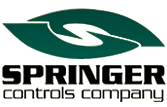A thermal overload, sometimes called a thermal overload relay, is an essential part of a motor starter. The contactor is there to act as the switch and transmit power to the motor. The overload is there to prevent damage to the motor if the motor starts drawing too much current, i.e. more than the rated full load amperage of the motor at the given voltage.
You can read our previous blog posts on motor starters to learn more:
After the thermal overload heats up and breaks contact to stop the motor, eventually you are going to want to restart the motor. The thermal overload has two ways it can be restarted, and this is a question we receive a lot from our customers, and there seems to be some confusion about how to decide. In the photo below you can see a blue knob that’s been circled:

This knob controls how the overload will be reset. It has two settings, AUTO and MANUAL. The overload in the photo is currently set to MANUAL.
Manual Reset
MANUAL reset means that once the overload trips, it will require outside intervention to restart the motor. This can be a human operator pressing a start button, or an external switch sending power to the contactor coil. It’s important to note, the motor will only restart once the overload relay has cooled enough to restore contact inside the overload relay. How long it takes for the overload to cool depends on many factors. Ambient temperature, airflow, sunlight can all affect how quickly the overload cools.
Auto Reset
AUTO reset means that once the bi-metal strip inside the overload relay cools and makes contact again, the motor will restart automatically. It does not require any outside intervention to restart the motor. Because the cooling rate of the overload is variable and not easily predicted, this means the motor can and will restart at any time without warning.
Auto Reset vs Manual Reset on Thermal Overload Relays
From a safety perspective, it’s easy to see how AUTO reset can be dangerous and should only be used in certain situations. Usually, AUTO reset is only used in cases where the motor is remote, and not monitored by any human on a regular basis. Before using AUTO reset, you must consider the potential consequences and dangers of the motor restarting at an unknown time. If there is any possibility of a dangerous condition being created by the motor starting randomly then AUTO reset should not be used. A remotely located well pump could be a situation where AUTO reset is used. In this case, it might make sense to have some kind of signal that the overload relay tripped so the source of the problem causing the motor to overheat can be investigated, however, AUTO reset will allow the motor to run for a period of time until it overheats again. In the well pump scenario, it would allow some water to be pumped before overheating again and the overheat>cool>AUTO reset>motor restart cycle would continue. Presumably, the user of the water could investigate why the water flow is reduced and fix the problem causing the motor to overheat.
In most other scenarios the MANUAL reset is preferred to allow a person to investigate the problem causing the motor to stop and ensure the safe restart of the motor. More than 95% of the motor starter applications we deal with use MANUAL reset just for this reason. It’s safer, and it allows time to discover and fix the source of the problem.
To inquire about our IEC starters and thermal overload relay selection, please request a quote from us at Springer Controls today!
